Sales of plant-based cheese and spreads across the Commonwealth of Independent States are estimated at USD 310 million in 2025, with forecasts indicating growth to USD 621.3 million by 2035, reflecting a CAGR of approximately 7.2% during the forecast period.
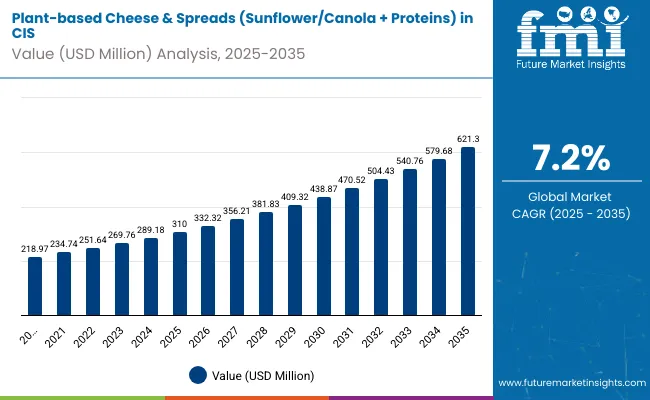
| Metric | Value |
|---|---|
| Industry Size (2025E) | USD 310 million |
| Industry Value (2035F) | USD 621.3 million |
| CAGR (2025 to 2035) | 7.2% |
This expansion represents both an emerging consumer base and increasing per capita adoption in major urban centers. The rising demand stems from evolving dietary preferences, heightened awareness of health benefits, and growing availability of alternative protein products. By 2025, per capita consumption in leading CIS countries such as Russia, Kazakhstan, and Ukraine averages between 0.08 to 0.12 kilograms, with projections reaching 0.19 kilograms by 2035.
Moscow leads among metropolitan areas, expected to generate USD 38 million in plant-based cheese and spreads sales by 2035, followed by St. Petersburg (USD 14 million), Almaty (USD 8 million), Kiev (USD 7 million), and Minsk (USD 5 million).
The primary contribution to demand originates from products using sunflower oil as the base, which are projected to represent 60% of total sales in 2025, supported by consumer familiarity, versatile applications, and lower production complexity compared to alternative formulations. By distribution pathway, supermarkets and hypermarkets constitute the leading retail format, accounting for 48% of all sales, while specialty health stores and online platforms demonstrate rapid expansion.
Consumer adoption concentrates particularly among health-conscious urban professionals and younger demographics, with education levels and disposable income serving as key demand drivers. Although pricing remains a barrier to broader adoption, the average price premium over conventional dairy cheese has decreased from 35% in 2020 to 22% in 2025.
Ongoing improvements in local production capabilities and regional brand development are expected to enhance affordability and accessibility across middle-income households. Geographic variations persist, but per capita demand in rapidly developing cities is progressively closing the gap with established metropolitan centers.
The plant-based cheese and spreads segment in the CIS is classified across multiple dimensions. By product type, primary categories encompass products using sunflower oil, canola oil blends, and other oil bases. By protein source, formulations include pea protein, soy protein, faba bean protein, and other protein alternatives. By distribution channel, the segment spans supermarkets and hypermarkets, specialty health stores, online grocery platforms, convenience stores, and traditional food retailers.
By consumer profile, the segment addresses health-conscious millennials, lactose-intolerant individuals, urban professionals, environmentally motivated consumers, and fitness enthusiasts. By region, coverage includes Russia, Kazakhstan, Ukraine, Belarus, Uzbekistan, and other CIS member states. By city, key metropolitan areas analyzed encompass Moscow, St. Petersburg, Almaty, Kiev, and Minsk.
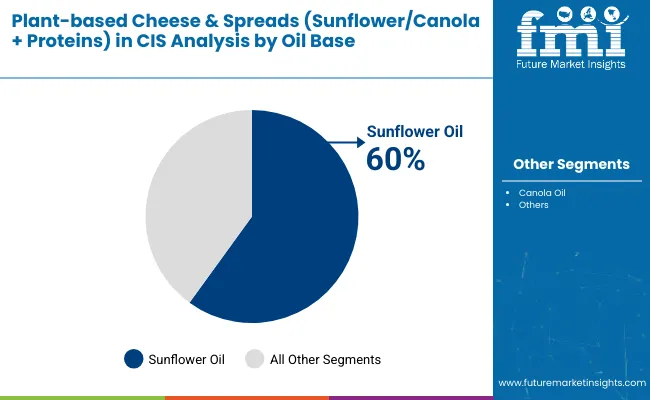
Sunflower oil-based products are positioned to dominate sales in 2025, benefiting from consumer acceptance, local ingredient availability, and cost-effectiveness across various applications. Alternative formulations including canola oil blends are experiencing steady growth, each addressing specific taste preferences and production requirements.
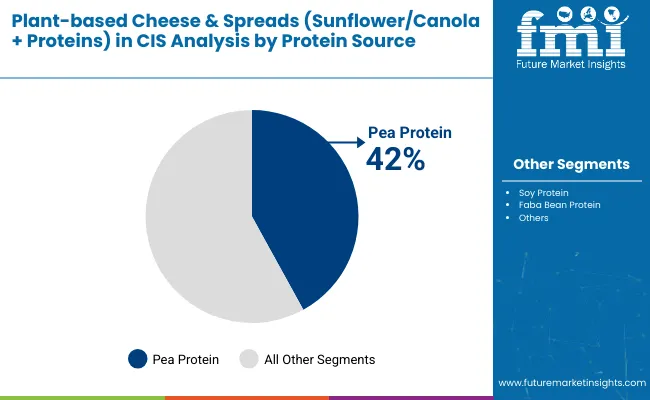
Plant-based cheese and spreads in the CIS utilize various protein foundations, selected for nutritional profiles, production costs, allergen considerations, and functional attributes. Pea protein maintains significant usage, while soy and faba bean alternatives are expanding their presence. Product developers increasingly explore regional ingredients and hybrid formulations to address local taste preferences.
Plant-based cheese and spreads in the CIS are distributed through diverse retail channels reflecting varied consumer shopping patterns. Supermarkets and hypermarkets are expected to maintain their position as the primary sales venue in 2025, followed by specialty health stores and emerging online platforms. Distribution strategies are adapting to accommodate regional preferences and infrastructure limitations.
The plant-based cheese and spreads category attracts a diverse consumer base spanning age groups, income levels, and dietary motivations. While drivers range from health concerns to environmental awareness to dietary restrictions, demand concentrates among five key demographic segments. Each group demonstrates distinct purchasing behaviors, channel preferences, and product expectations.
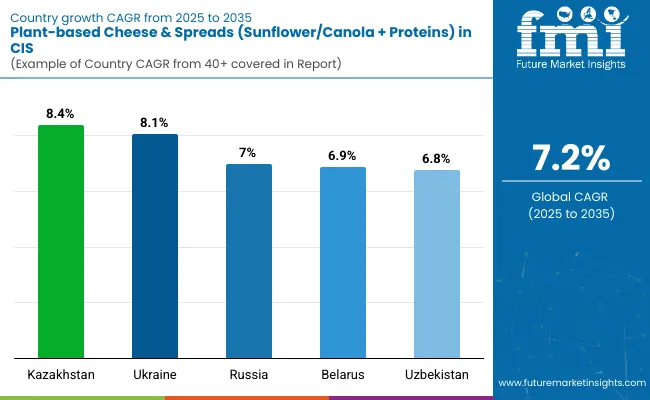
| Countries | CAGR (2025 to 2035) |
|---|---|
| Kazakhstan | 8.4% |
| Ukraine | 8.1% |
| Russia | 7% |
| Belarus | 6.9% |
| Uzbekistan | 6.8% |
Plant-based cheese and spreads sales will not expand uniformly across all metropolitan areas. Increasing urbanization and accelerating per-capita adoption in developing economic centers provide Kazakhstan and Ukraine with notable advantages, while established regions such as Russia grow more gradually from higher baseline levels. The table below displays the compound annual growth rate (CAGR) each of the five leading countries is expected to achieve between 2025 and 2035.
Between 2025 and 2035, demand for plant-based cheese and spreads is projected to expand across all major CIS countries, though growth rates will vary based on economic development, retail infrastructure advancement, and baseline consumption patterns. Among the five countries analyzed, Kazakhstan and Ukraine are expected to register the highest compound annual growth rates of 8.4% and 8.1% respectively, surpassing more mature regional centers.
This acceleration reflects several converging factors: rapid economic development, expanding middle-class populations, and increasing availability of specialty food products through modern retail formats. In both countries, per capita consumption is projected to rise significantly, narrowing the consumption gap with higher-adoption countries such as Russia. Product assortment is also expanding more rapidly in these regions, with new international brands and local manufacturing initiatives gaining traction in supermarkets and specialty stores.
Russia is forecast to grow at a CAGR of 7% over the same period, maintaining its position as the largest absolute contributor while demonstrating steady expansion from its established base. Growth is supported by a developed retail ecosystem with widespread access to plant-based cheese and spreads through supermarkets, health stores, and online platforms.
Belarus and Uzbekistan demonstrate similar growth trajectories at 6.9% and 6.8% respectively, reflecting gradual mainstream acceptance of plant-based dairy alternatives supported by increasing health consciousness and expanding product availability.
Collectively, these countries represent the foundation of regional demand for plant-based cheese and spreads in the CIS, with their distinct growth trajectories highlighting the significance of localized approaches in product development, pricing strategies, and distribution channel optimization.
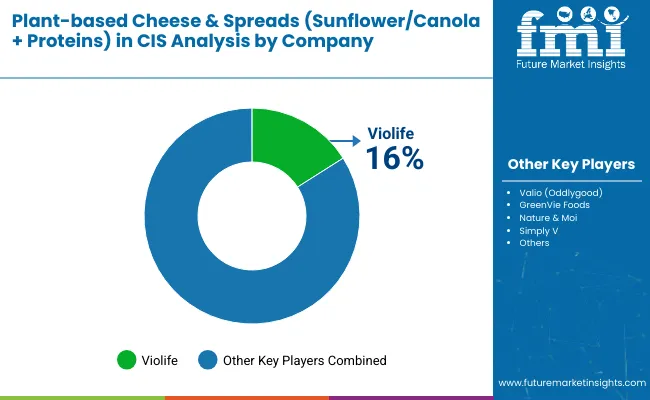
The competitive landscape is characterized by a combination of international brands and emerging local producers. Distribution reach and product innovation capabilities remain critical success factors, with the leading suppliers collectively accessing significant retail presence across the region and securing notable shelf space in dairy and health food sections.
Violife stands as the leading participant with a 16% share, leveraging its European expertise and established formulations to capture significant presence across major retail chains. The company's comprehensive product range and premium positioning strategies resonate particularly well with health-conscious urban consumers.
Other key players including GreenVie Foods, Natura & Moi, and Simply V collectively represent the remaining competitive landscape, each bringing specialized approaches to product development, distribution strategies, and consumer engagement. These companies benefit from varying degrees of international experience, local market adaptation, and retail partnership development.
The competitive environment includes established food manufacturers exploring plant-based extensions, specialty food producers focusing on premium offerings, and emerging local brands developing regionally-specific formulations. Consolidation dynamics are influenced by manufacturing capabilities, distribution network access, and brand recognition factors.
Regional market development continues to create opportunities for both international expansion and local innovation, with success factors increasingly tied to production efficiency, retail relationship management, and consumer education initiatives in this evolving category.
| Attribute | Details |
|---|---|
| Study Coverage | CIS sales and consumption of plant-based cheese and spreads from 2020 to 2035 |
| Base Year | 2025 |
| Historical Data | 2020 |
| Forecast Period | 2025-2035 |
| Units of Measurement | USD (sales), Metric Tonnes (volume), Kilograms per capita (consumption) |
| Geography Covered | All CIS member states; country-level and city-level granularity |
| Top Countries Analyzed | Russia, Kazakhstan, Ukraine, Belarus, Uzbekistan, 10+ |
| Top Cities Analyzed | Moscow, St. Petersburg, Almaty, Kiev, Minsk and 30+ |
| By Product Format | Sunflower oil-based products, Canola oil blends, Other oil bases |
| By Protein Source | Pea protein, Soy protein, Faba bean protein, Others |
| By Distribution Channel | Supermarkets/hypermarkets, Specialty health stores, Online grocery, Convenience stores, Traditional retailers |
| By Consumer Profile | Health-conscious millennials, Lactose-intolerant individuals, Urban professionals, Environmentally motivated consumers, Fitness enthusiasts |
| Metrics Provided | Sales (USD), Volume (MT), Per capita consumption (kg), CAGR (2025-2035), Share by segment |
| Price Analysis | Average unit prices by product format and region |
| Competitive Landscape | Company profiles, private label strategies, regional presence, local vs. international brands |
| Forecast Drivers | Per capita demand trends, retail expansion, health awareness, urbanization effects |
By 2035, total CIS sales of plant-based cheese and spreads are projected to reach USD 621.3 million, up from USD 310 million in 2025, reflecting a CAGR of approximately 7.2%.
Sunflower oil-based products hold the leading share, accounting for approximately 60% of total sales in 2025, followed by canola oil blends and other oil-based formulations.
Kazakhstan and Ukraine lead in projected growth, registering CAGRs of 8.4% and 8.1% respectively between 2025 and 2035, driven by economic development and expanding retail infrastructure.
Supermarkets and hypermarkets are the dominant sales channel (48% share in 2025), while specialty health stores and online platforms are experiencing rapid double-digit growth in urban regions.
Major players include Violife (16% share), GreenVie Foods, Natura & Moi, Simply V, and Uniconf, with increasing competition from international brands and emerging private label offerings from major retail chains.






Our Research Products

The "Full Research Suite" delivers actionable market intel, deep dives on markets or technologies, so clients act faster, cut risk, and unlock growth.

The Leaderboard benchmarks and ranks top vendors, classifying them as Established Leaders, Leading Challengers, or Disruptors & Challengers.

Locates where complements amplify value and substitutes erode it, forecasting net impact by horizon

We deliver granular, decision-grade intel: market sizing, 5-year forecasts, pricing, adoption, usage, revenue, and operational KPIs—plus competitor tracking, regulation, and value chains—across 60 countries broadly.

Spot the shifts before they hit your P&L. We track inflection points, adoption curves, pricing moves, and ecosystem plays to show where demand is heading, why it is changing, and what to do next across high-growth markets and disruptive tech

Real-time reads of user behavior. We track shifting priorities, perceptions of today’s and next-gen services, and provider experience, then pace how fast tech moves from trial to adoption, blending buyer, consumer, and channel inputs with social signals (#WhySwitch, #UX).

Partner with our analyst team to build a custom report designed around your business priorities. From analysing market trends to assessing competitors or crafting bespoke datasets, we tailor insights to your needs.
Supplier Intelligence
Discovery & Profiling
Capacity & Footprint
Performance & Risk
Compliance & Governance
Commercial Readiness
Who Supplies Whom
Scorecards & Shortlists
Playbooks & Docs
Category Intelligence
Definition & Scope
Demand & Use Cases
Cost Drivers
Market Structure
Supply Chain Map
Trade & Policy
Operating Norms
Deliverables
Buyer Intelligence
Account Basics
Spend & Scope
Procurement Model
Vendor Requirements
Terms & Policies
Entry Strategy
Pain Points & Triggers
Outputs
Pricing Analysis
Benchmarks
Trends
Should-Cost
Indexation
Landed Cost
Commercial Terms
Deliverables
Brand Analysis
Positioning & Value Prop
Share & Presence
Customer Evidence
Go-to-Market
Digital & Reputation
Compliance & Trust
KPIs & Gaps
Outputs
Full Research Suite comprises of:
Market outlook & trends analysis
Interviews & case studies
Strategic recommendations
Vendor profiles & capabilities analysis
5-year forecasts
8 regions and 60+ country-level data splits
Market segment data splits
12 months of continuous data updates
DELIVERED AS:
PDF EXCEL ONLINE
Precision-Fermented Casein for QSR Pizza Cheese Market Analysis - Size, Share, and Forecast Outlook 2025 to 2035
Cheese Packaging Market Forecast and Outlook 2025 to 2035
Cheese Concentrates Market Size and Share Forecast Outlook 2025 to 2035
Cheese Ingredient Market Size and Share Forecast Outlook 2025 to 2035
Cheese Color Market Size and Share Forecast Outlook 2025 to 2035
Cheese Market Size and Share Forecast Outlook 2025 to 2035
Cheese Cutting Machine Market Size and Share Forecast Outlook 2025 to 2035
CIS Insulin Market Size and Share Forecast Outlook 2025 to 2035
Spreads Market Size and Share Forecast Outlook 2025 to 2035
Cheese Flavor Market Size, Growth, and Forecast for 2025 to 2035
Cheese Market Analysis - Size, Share, and Forecast Outlook 2025 to 2035
Cheese Powder Market Size, Growth, and Forecast for 2025 to 2035
Cheese Alternatives Market Analysis - Size, Share, and Forecast 2025 to 2035
Cheese Analogue Market Insights - Growth & Demand Analysis 2025 to 2035
Spreads and Toppings Packaging Market Trends – Growth & Forecast 2025 to 2035
Cissus Quadrangularis Market Analysis by Product Form, Grade, End Use and Sales Channel Through 2035
Cheese Liners Market
Scissor Lift Market Size and Share Forecast Outlook 2025 to 2035
Decision Intelligence Market Forecast and Outlook 2025 to 2035
Decision Management Applications Market Size and Share Forecast Outlook 2025 to 2035

Thank you!
You will receive an email from our Business Development Manager. Please be sure to check your SPAM/JUNK folder too.
Chat With
MaRIA